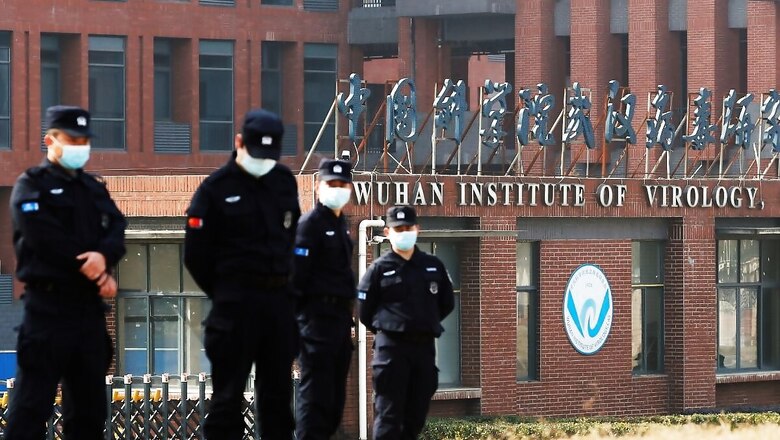
views
Eighteen months after the COVID-19 pandemic swept across the world with devastating effects, we are still no closer to finding the origin of the virus. Many experts have raised concerns that the virus could have leaked from a lab at the Wuhan Institute of Virology. Irrespective of which theory is subsequently proved (if at all), what is amply clear is that the weaponization of pathogens can have terrifying consequences. It is also a fact that the capability of developing biological weapons exists in most countries that are engaged in pharmaceutical and medical research.
The use of biological weapons is not a new or unique phenomenon. In 1345, the Mongols had laid siege to the city of Caffa, a port on the Black Sea, when the Black Death plague struck them. Demoralised and stunned by their disaster, the Mongols catapulted corpses of their dead into the city, infecting the citizens. After the siege ended in 1347, the city’s survivors sailed to Europe, taking the plague with them. By 1348, Europe was in the grip of the Black Death that would kill more than 20 million people, almost one-third of the continent’s population.
The Race for Bio Weapons
During the Second World War, the Japanese had an advanced biological weapons programme that carried out experiments on prisoners of war. Japan’s biological warfare from 1932 to 1945 in Manchuria and China is described in chilling details in Sheldon H. Harris’s book Factories of Death. In 1939 and 1940, Unit 731 (responsible for biological warfare) laced more than 1,000 wells in and around Harbin in Manchuria with typhoid bacilli that devastated entire villages. In a shocking post-war development, America granted immunity to the physicians of Unit 731 in exchange for providing America with their research on biological warfare and data from human experiments.
ALSO READ | Wuhan Lab Leak Theory: India Must Lead Global Probe into Origins of the Virus & Its Cover-up
Research into biological weapons intensified after the Second World War, led by the US and the Soviet Union. By 1969, when President Nixon ended the US’ offensive biological warfare programme, it had developed six mass-produced, battle-ready biological weapons in the form of agents that cause anthrax, tularemia, brucellosis, Q-fever, Venezuelan equine encephalitis (VEE) and botulism. The US decision spurred the adoption of the 1972 Biological and Toxin Weapons Convention (BWC), which banned the development, production, stockpiling, transfer and use of biological and toxin weapons.
Today, 183 states have either ratified or acceded to the BWC. However, unlike the chemical or nuclear weapons regimes, the BWC lacks an effective system to verify states’ compliance with the convention. This has led to many accusations that countries are breaching the obligations of the convention. In 1973, the Soviet Union established Biopreparat, a giant network of secret labs working on biological agents. In 1992, Colonel Kanatjan Alibekov, the First Deputy Director of Biopreparat, defected to the US and revealed the scale of the Soviet programme: from perfecting biological weapons based on anthrax, glanders, and plague to weaponizing highly contagious viral diseases such as smallpox and Ebola.
A Need for Transparent Systems
Not much is publicly known about China’s biological weapons programme. An April 2021 US Department of State report noted that there are “concerns with respect to Chinese military medical institutions’ toxin research and development because of the dual-use applications and their potential as a biological threat.” Recent media reports indicated that a 2015 Chinese document, The Unnatural Origin of SARS and New Species of Man-Made Viruses as Genetic Bioweapons, had discussed the weaponization of the coronavirus.
While there is some concern over nations clandestinely continuing with building of biological weapons, there is also the added threat from terrorist groups. Aum Shinrikyo, a Japanese terrorist group that attacked the Tokyo subway system with Sarin gas in 1995, was also involved in developing biological weapons using Anthrax and Ebola virus. Although there have been no major bioterrorist attacks, there is no doubt about the intent of terrorist groups to acquire weapons of mass destruction. In the 2012 edition of the al Qaeda magazine Inspire, Anwar al-Awlaki, a senior leader, quotes Islamic scholars to justify “the use of poisons of chemical and biological weapons against population centers.”
ALSO READ | How The Demand For Probe Into Covid-19 Origin And The Lab Leak Theory Gained Ground
Advances in biotechnology also pose a serious threat to national security. The 2016, 2017 and 2019 annual editions of the Worldwide Threat Assessment of the US Intelligence Community included genome editing as a developing risk. Researchers have been able to replicate CRISPR, or Clustered Regularly Interspersed Short Palindromic Repeats, a mechanism by which bacteria remove viruses from their DNA. There are fears that techniques like CRISPR can be used to modify a pathogen’s DNA to make it more virulent or target people with certain genetic traits.
Bio defence research is continuing around the world with a great deal of opacity. While most countries are signatories to the BWC, the treaty lacks teeth, and there is no effective method to ensure compliance by nations. The COVID-19 pandemic has shown us the extreme vulnerability of the world’s population to an unknown virus. There is no surety that such an event will not naturally occur in the future, but we could at least minimise the chances of deadly biological weapons escaping from secret labs. This will require strengthening the BWC, greater transparency in national programmes, and international scientific cooperation to defend against biological threats.
Countries must put in place measures to quickly detect and respond to all forms of biological attacks. Most of all, there is a need for leaders around the world to take a principled stand on biological weapons. In 1998, Richard Preston, a bestselling author of books on infectious disease, penned down words that remain equally relevant today: “Biological weapons are a disgrace to biology. The time has come for top biologists to assert their leadership and speak out, to take responsibility on behalf of their profession for the existence of these weapons and the means of protecting the population against them, just as leading physicists did a generation ago when nuclear weapons came along. Moral pressure costs nothing and can help; silence is unacceptable now.”
Read all the Latest News, Breaking News and Coronavirus News here.




















Comments
0 comment